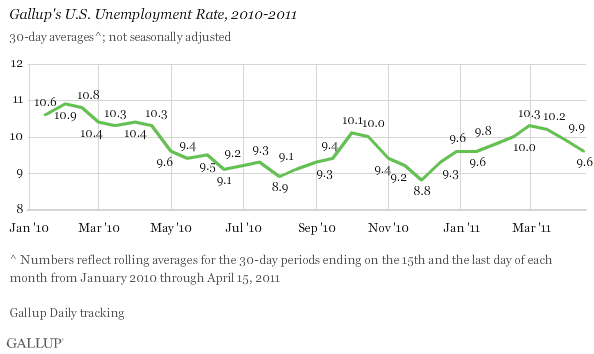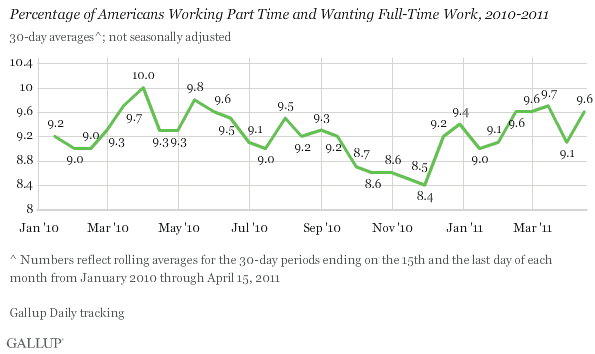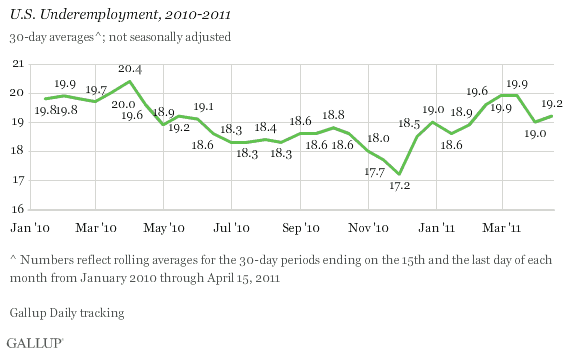PRINCETON, NJ -- Unemployment, as measured by Gallup without seasonal adjustment, fell to 9.6% in mid-April from 9.9% at the end of March, and is at its lowest level since mid-January. The current 9.6% unemployment rate is down from 10.3% in mid-April a year ago.

The percentage of part-time workers who want full-time work was 9.6% in mid-April -- up from 9.1% at the end of March but essentially unchanged from 9.7% in mid-March. More U.S. workers are now working part time but seeking full-time work than was true a year ago (9.3%).

Broader Underemployment Increased Slightly in Mid-April
The decline in unemployment since late March was not enough to offset the larger increase in those working part time but wanting full-time work. As a result, the combined underemployment measure increased to 19.2% in mid-April from 19.0% at the end of March. Underemployment is now slightly below the 19.6% of mid-April a year ago.

Jobs Situation Slightly Better Than a Year Ago
Several of Gallup's economic indicators tend to support the finding that there has been some improvement in the U.S. job environment over the past year. Specifically, 17% of Americans now say it is a good time to find a quality job, the most since early September 2008. Similarly, Gallup's Job Creation Index remains at its best level in more than two years.
However, Gallup's unemployment measure shows the jobs improvement of the past year to be modest at best -- particularly given the rate at which jobs disappeared during the recession. There has been no improvement in Gallup's unemployment measure since mid-January and even the government's seasonally adjusted reports show that the U.S. unemployment rate declined relatively modestly, from 9.0% in January to 8.8% in March. In addition, unemployment according to Gallup has improved by less than one full percentage point over the past year. Further, underemployment has deteriorated since mid-January and shows an even more modest year-over-year improvement.
In essence, the declines in Gallup's U.S. unemployment rate this year are running about two weeks ahead of the declines from last year. By May 1, 2010, Gallup's unemployment measure was down to 9.6% -- right where it now stands, two weeks earlier in 2011. In turn, this suggests the recent modest improvement in the jobs situation is due, at least in part, to seasonal hiring trends coming from more jobs activity at this time of year.
Gallup's economic data also show consumer optimism down sharply and spending no better than it was a year ago. Barring a major change in this economic environment, it seems likely that business owners' optimism and employers' hiring intentions will also deteriorate in the months ahead, creating an even more challenging jobs situation. It's no surprise, then, that Americans continue to report jobs as a top national priority.
Gallup.com reports results from these indexes in daily, weekly, and monthly averages and in Gallup.com stories. Complete trend data are always available to view and export in the following charts:
Daily: Employment, Economic Confidence and Job Creation, Consumer Spending
Weekly: Employment, Economic Confidence, Job Creation, Consumer Spending
Read more about Gallup's economic measures.
View our economic release schedule.
Survey Methods
Gallup classifies American workers as underemployed if they are either unemployed or working part time but wanting full-time work. The findings reflect more than 18,000 phone interviews with U.S. adults aged 18 and older in the workforce, collected over a 30-day period. Gallup's results are not seasonally adjusted and are ahead of government reports by approximately two weeks.
Results are based on telephone interviews conducted as part of Gallup Daily tracking from March 16-April 15, 2011, with a random sample of 18,195 adults, aged 18 and older, living in all 50 U.S. states and the District of Columbia, selected using random-digit-dial sampling.
For results based on the total sample of national adults, one can say with 95% confidence that the maximum margin of sampling error is ±1 percentage point.
Interviews are conducted with respondents on landline telephones and cellular phones, with interviews conducted in Spanish for respondents who are primarily Spanish-speaking. Each sample includes a minimum quota of 400 cell phone respondents and 600 landline respondents per 1,000 national adults, with additional minimum quotas among landline respondents for gender within region. Landline telephone numbers are chosen at random among listed telephone numbers. Cell phones numbers are selected using random digit dial methods. Landline respondents are chosen at random within each household on the basis of which member had the most recent birthday.
Samples are weighted by gender, age, race, Hispanic ethnicity, education, region, adults in the household, and phone status (cell phone-only/landline only/both, cell phone mostly, and having an unlisted landline number). Demographic weighting targets are based on the March 2010 Current Population Survey figures for the aged 18 and older non-institutionalized population living in U.S. telephone households. All reported margins of sampling error include the computed design effects for weighting and sample design.
In addition to sampling error, question wording and practical difficulties in conducting surveys can introduce error or bias into the findings of public opinion polls.
For more details on Gallup's polling methodology, visit www.gallup.com.
